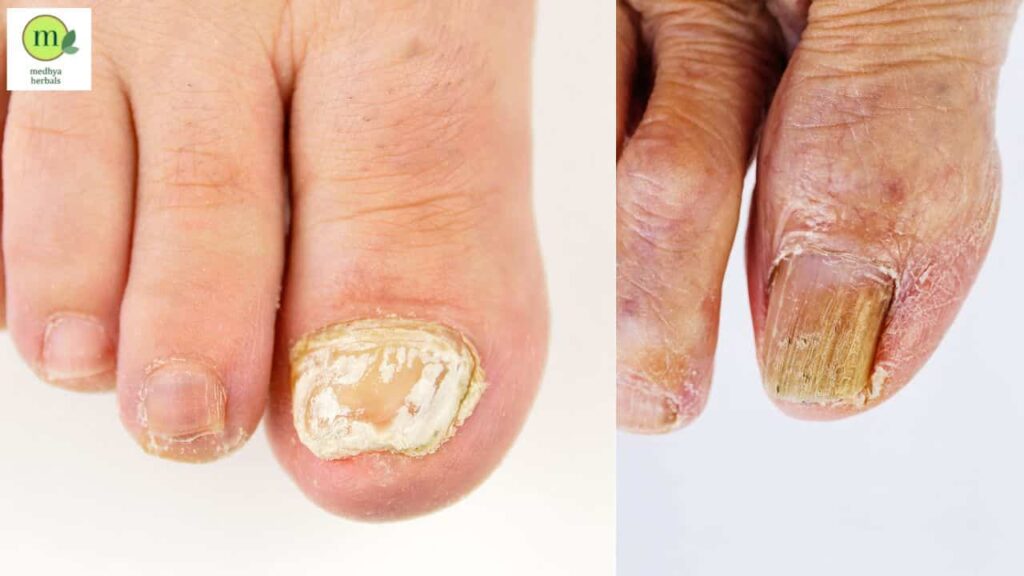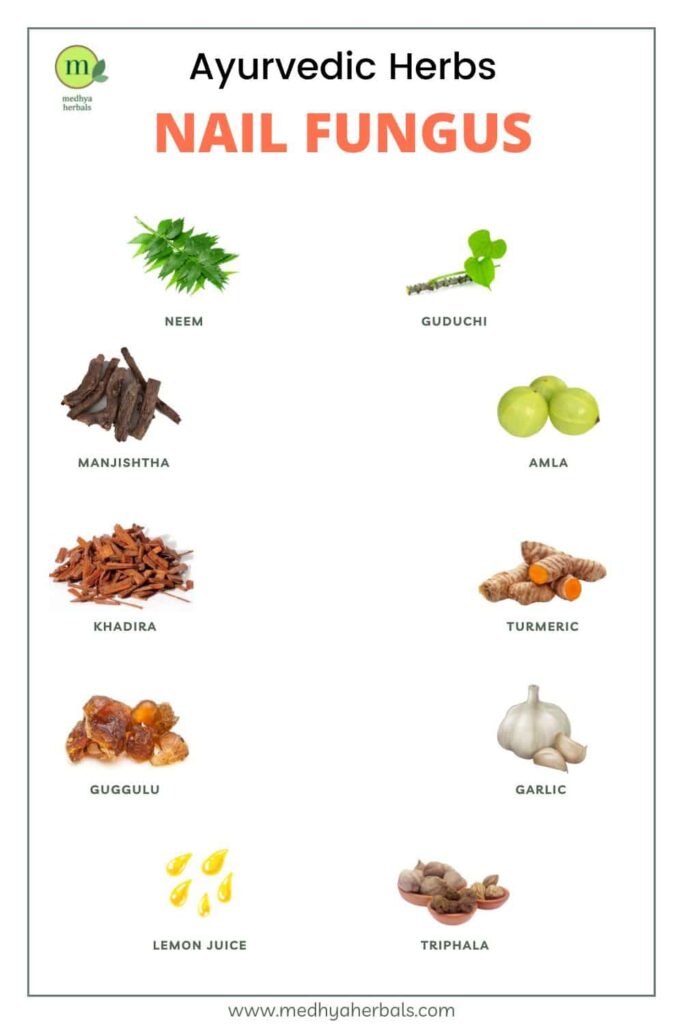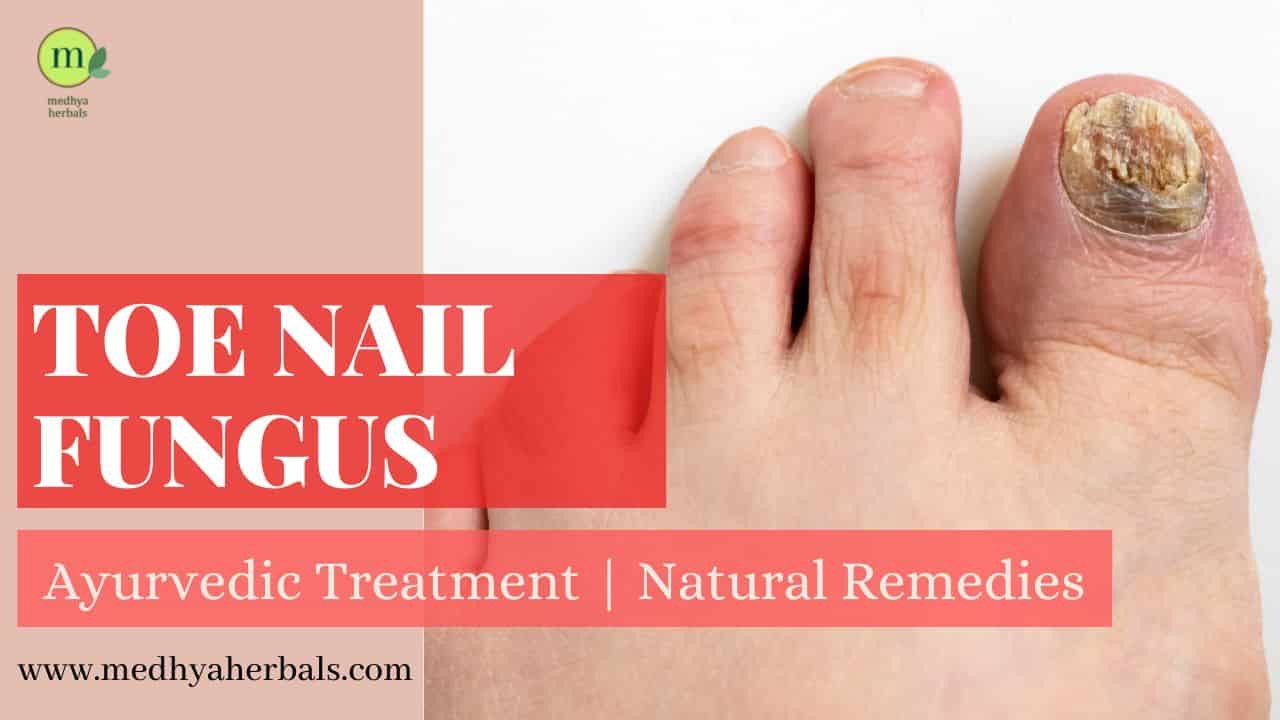Toenail fungus, also known as onychomycosis, is a common condition that affects millions of people worldwide. While there are many conventional treatments available, such as oral anti fungal medications or topical creams, these can often be ineffective and come with a range of side effects.
If you’re looking for a safe and effective way to get rid of the unsightly and painful nail infection, Ayurveda can help you out. Ayurveda is holistic natural medicine system that is based on the principle of balance between body, mind, and spirit. The goal of Ayurvedic treatment is to restore this balance and promote overall health and well-being.
There are a number of different Ayurvedic treatments for fungal nail infection, such as herbal antifungals, topical applications, and internal cleansing. These treatments are highly effective in helping to get rid of the fungal infection and prevent it from coming back.
What is Nail Fungus?
Nail fungus is a fungal skin infection, which invades the nails and the nail bed. It is commonly caused by a type of fungus called dermatophytes and can be found in nearly 2-3% of the population worldwide.

It is also known as onychomycosis or Tinea unguium, a condition that can affect both toenails and fingernails. However, it is more commonly seen in toenails than finger nails. Nail fungus can cause the nails to become discolored, thickened, and brittle. The affected nails may also emit a foul odor. In severe cases, the nails may separate from the nail bed.
Symptoms of Nail Fungus
Toenail fungal infection begins as a small white or yellow spot on your nail. As it spreads deeper, the color of your nail changes, resulting in an thickened, brittle and uneven nail. The appearance of white or yellow streaks on the nail, scaling beneath the nail, flakiness or crumbling of the nails are all indicators of infection by fungi. It can also lead to pain, irritation, and burning.
If you have nail fungal infection, you may notice one or more of the following symptoms:
– Discoloration of the nails, usually a yellow or brownish color
– Thickening of the nails
– Brittle nails
– Nails that emit a foul odor
– Nails that are separated from the nail bed
Nail fungal infection can be highly contagious and difficult to treat on your own. It is important to see a doctor or an ayurvedic practitioner for proper diagnosis and treatment.
Health complications of Toenail fungal infection
If left untreated, fungal nail infection can lead to a number of health complications. The most common complication is the spread of the infection to other nails. The fungus can also spread to the skin around your nails, causing athlete’s foot. Toenail fungus can also cause serious damage to your nails, making them more likely to crack or break. In severe cases, it can lead to permanent damage to your nails and may even require surgery.
Another potential complication of fungal infection is cellulitis, a serious bacterial infection of the skin. Cellulitis can occur if the fungus spreads to the skin around your nails and causes an open wound. If you have cellulitis, you may experience fever, chills, redness and swelling. Cellulitis can be a very serious condition and requires immediate medical treatment.
If you have toenail fungus, it is important to see a doctor or an Ayurvedic practitioner so that you can avoid these serious complications. With proper treatment, fungal growth can be effectively treated and the risk of these complications can be greatly reduced.
Causes of Nail Fungus
Fungal growth in nails is more common in older adults, because the nails become thicker and slower-growing with age, which makes them more susceptible to infection. There are a number of different factors that can contribute to the development of toenail fungus.
- Certain health conditions, such as diabetes, under active thyroid, pcos or a weakened immune system.
- Wearing tight-fitting shoes or having sweaty feet
- Walking barefoot in public places, such as locker rooms or swimming pools.
- Having a family member with toenail fungus.
- Injury to the nails
- Skin disease such as psoriasis or foot fungus as athletes foot
- Unhygienic conditions of the nails or keeping them moist for prolonged periods
Diagnosis of Fungal Infection in Nails
Nail fungus is usually diagnosed based on a physical examination and a medical history. Your doctor will likely ask about your symptoms and when they began. He or she may also ask about your medical history, including any previous fungal infections . A sample of the affected nail may also be taken for laboratory testing.If you have toenail fungus, your doctor may recommend one or more of the following tests:
- KOH test: A sample of the affected nail is placed on a slide and mixed with potassium hydroxide. This helps to identify the type of fungus that is causing the infection.
- Culture test: A sample of the affected nail is placed on a slide and placed in a culture dish to grow the fungus. This helps to identify the type of fungus that is causing the infection.
- Nail clipping: A small piece of the nail is clipped and sent to a laboratory for analysis.
Ayurvedic Perspective of Nail Fungus
Nail fungal infection is called “Kunakha” (disorder or discoloration of nails) in Ayurveda. It is a condition that results from imbalance in all three dosha, vata, pitta and kapha. Discoloration of the nail and related symptoms will vary depending on the intensity and type of dosha involved:
- Pitta dosha: burning sensation, pain, foul smell, red color
- Vata dosha: pricking throbbing pain, brittle and dry nail, dark grey, black or brown color
- Kapha dosha: dull pain, thick nail separated from nail bed, white, yellow color
In Ayurveda, nail fungus can happen as a result of reduced immunity and a faulty lifestyle involving fast foods, processed and sugary foods, unhygienic conditions, excess heat or dampness.
Ayurvedic Treatment for Fungal Nail Infection
Ayurveda recommends internal detoxification and immune boosting treatment to treat nail fungus at the root cause level.
Ayurvedic treatment for nail fungus helps to naturally controlling the growth of fungus, healing the affected tissues and eliminating the fungus completely. There are multiple Ayurvedic medicines that are potent anti fungal and anti microbial agents. In addition, external remedies and specific diet & lifestyle changes also help to heal the nails fast.
Ayurvedic herbs for treatment of nail fungus
There are a number of different Ayurvedic herbs that can be used to treat nail fungus. Some of the most common herbs include:

Neem: Neem is a potent medicinal herb with antifungal properties. It can help to kill the fungus and help with itching. It aids in the treatment of ringworm, athlete’s foot, and nail fungus. It’s a strong alternative therapy for skin disease.
Guduchi: Guduchi has powerful antimicrobial and antifungal properties. It stops the growth of fungi, bacteria and yeast. It also helps to get rid of the symptoms like pain, discoloration, and brittleness of the nails. Guduchi is also effective in candida and bacterial vaginosis.
Khadira: Khadira is an Ayurvedic medicine that’s frequently used to cure skin disorders. It has a strong astringent action and can help with fungal and yeast infection. It may also function as a blood purifier and detoxifying agent, ensuring a quicker recovery.
Triphala Guggulu: Triphala Guggulu provides effective treatment for toenail fungus because it helps to get rid of the symptoms through its antifungal and antioxidant action. It also protects the toenail and skin from further damage.
Manjishtha: Manjishtha is an ayurvedic herb that’s often used to treat skin conditions like psoriasis, eczema, and dermatitis. It can also help with the symptoms of toenail fungus by reducing inflammation and pain.
Amla: Amla is an Ayurvedic herb that’s frequently used to treat a wide range of skin diseases. It’s rich in antioxidants and can help to reduce the inflammation and boost your immunity against fungal infections. Amla can also help to protect the nails from further damage.
Turmeric: Turmeric is a powerful anti-inflammatory herb that can help to reduce the swelling and pain associated with nail fungus.
Ayurvedic lifestyle tips to prevent & treat Nail Fungus
Practicing an Ayurvedic lifestyle can really help to balance the dosha, boost your immunity and help to treat the toenail fungus fast. Here are the most important lifestyle changes that you should be making to find relief from nail fungus:

- Hygiene: Toenail fungus is often caused by damp and humid conditions. It’s important to keep your feet clean and dry to prevent the fungus from spreading. Wear sandals or open-toed shoes whenever possible to allow your feet to breathe. Avoid wearing tight shoes that will make your feet sweat.
- Diet: Toenail fungus is often caused by a weakened immune system. To boost your immunity, eat a healthy diet that’s rich in fresh fruits and vegetables. Include plenty of immunity-boosting foods like garlic, turmeric, ginger, and amla in your diet. Avoid sugary and processed foods as they can make the fungus worse.
- Exercise: Exercise is important for boosting your immunity and helping your body to fight off infections. Regular exercise will also help to improve circulation in your feet, which can help to prevent the fungus from spreading.
- Stress reduction: Toenail fungus can often be made worse by stress. To reduce stress, practice yoga or meditation on a regular basis. Spend time outdoors in nature and get plenty of restful sleep every night.
- Blood Sugar Balance: Toenail fungus is often made worse by high blood sugar levels. To keep your blood sugar in check, eat a healthy diet and exercise regularly. If you have diabetes, it’s important to control your blood sugar levels with medication.
Home Remedies for treatment of Nail Fungus
There are a number of home remedies that can be effective in the treatment of toenail fungus. Here are some of the most popular options:
Essential Oils
Tea tree oil has antifungal and antibacterial properties that make it an effective treatment for toenail fungus. To use, mix tea tree essential oil with base oil such as coconut oil or olive oil and apply it to the affected area with a cotton ball. Leave it on for at least 30 mins. After this, gently scrub off the area using a soft brush. Repeat this process twice a day until the fungus clears up and you observe growth of healthy nails.
Oregano oil: Oregano oil is another essential oil that can be effective in treating toenail fungus. Use it in exactly similar way as tea tree oil.
Apple Cider Vinegar
Due to its acidic nature, apple cider vinegar helps to kill the fungus and also prevents it from spreading. To use, mix one part apple cider vinegar with two parts water and soak your feet in it for 15-30 mins. After this, gently scrub the feet and dry them properly.
You can also apply tea tree oil or oregano oil afterwards on the feet.
Borax
Borax is a natural fungicide that can be effective in treating toenail fungus. To use, mix equal amount of borax and baking soda (another home remedy to control fungus growth) to make a thick paste with water. Apply this paste on the affected area and let it seep in for 30 mins. After this, rinse and dry your feet properly and repeat the process daily until you observe an improvement.
Garlic
Garlic is a natural antifungal and antibacterial agent that can be effective in treating toenail fungus. To use, crush a few cloves of garlic to make a paste and apply it on the affected area. Leave it on for 10 mins and then wash off with lukewarm water. Repeat this process twice a day until you see fungus reciding off and healthy nails start to appear.
Neem leaf Oil
Neem oil is an Ayurvedic home remedy for fungal infections. To use, mix neem oil with an equal amount of tea tree oil and apply it on the affected area. Leave it on for 30 mins and then gently scrub off the area. Repeat this process twice a day for best results.
Lemon Juice
Lemon juice is another Ayurvedic home remedy that can be used to treat toenail fungus. To use, mix lemon juice with equal parts of coconut oil and apply it on the affected area using a cotton ball. Leave it on for 10 mins before rinsing off with lukewarm water. Repeat this process 2-3 times a day for best results.
Takeaway
If you’re struggling with toenail fungus, make sure to talk to your Ayurvedic practitioner about the best course of treatment for you. There are a number of different herbs and lifestyle changes that can really help to improve your condition. With the right treatment, you can get rid of the fungus fast and enjoy healthy, beautiful nails.
Consult with Medhya’s Ayurvedic Doctor to get your personalised health plan involving prescription for Ayurvedic medicine, diet, yoga and lifestyle guidelines.
FAQ
1. How do I get rid of nail fungus on my toes?
Nail fungus is a common condition that can be difficult to get rid of. There are many over-the-counter treatments available, but these often have limited success. If you’re looking for a more effective treatment, you may want to try an Ayurvedic approach. Ayurveda is a system of medicine that emphasizes the use of natural remedies. One of the most popular Ayurvedic treatments for nail fungus is application of a paste made from powdered neem leaves. This paste can help to kill the fungus and speed up the healing process. In addition, neem is known for its ability to boost the immune system, which can help the body fight off infection more effectively. For best results, apply the paste directly to the affected nails and allow it to sit for 30 minutes before washing it off. Repeat this process once or twice daily until the fungus has cleared.
2. Can hormones cause toe nail fungus?
There are many different factors that can contribute to the development of toe nail fungus. One of the most important of these is hormones. Hormonal changes can alter the environment of the nails, making them more hospitable to fungal growth. This is often seen in pregnant women and menopausal women, who are more likely to develop nail fungus. In addition, people who take hormone replacement therapy or birth control pills may also be at increased risk. If you are concerned about your risk of developing toe nail fungus, it is important to speak with your doctor about ways to reduce your risk.
3. Can toenail fungus be cured?
Toenail fungus, also known as onychomycosis, is a common fungal infection of the nails. The main symptom of toenail fungus is a white or yellow spot under the tip of the nail, which may eventually spread to the entire nail. In some cases, the nail may become thickened or distorted. Although toenail fungus is not usually painful, it can be unsightly and difficult to treat.
There are several effective treatments for toenail fungus, including oral antifungal medications and topical creams. In most cases, toenail fungus can be cured with proper treatment. however, it is important to be patient, as it may take several months for the infection to clear completely. Additionally, while some people may only experience a mild case of toenail fungus, others may develop a more serious form of the infection that can lead to permanent damage to the nail. If you think you have toenail fungus, it is important to see a doctor so that you can receive the appropriate treatment.
4. How to know if Toenail fungus is dying?
If you have toenail fungus, you may notice your nails becoming thicker and more discolored. The edges of the nail may become ragged and yellow, and the nails may begin to crumble. As the fungus grows, it can cause the nails to become misshapen and deformed. In some cases, the nails may even fall off altogether.
If you suspect that you have toenail fungus, there are a few things you can do to determine if the infection is dying. First, take a close look at your nails. If they appear thinner and healthier than before, this is a good sign that the fungus is receding. You should also notice an improvement in color. If your nails are returning to their natural hue, this is another indication that the fungus is on the retreat.
Finally, pay attention to any pain or discomfort you are experiencing. If the itching and burning associated with toenail fungus are subsiding, this is a good sign that the infection is being controlled. If you have any concerns about your health, be sure to consult with your doctor for further guidance.
5. What is the main cause of toenail fungus?
One of the most common questions I am asked is ‘What is the main cause of toenail fungus?’ The answer, unfortunately, is not a simple one. Toenail fungus can be caused by a variety of factors, including tight-fitting shoes, sweaty feet, and a weakened immune system. However, the most common cause of toenail fungus is direct contact with someone who already has the infection. This can happen in public places like locker rooms or showers, or even in your own home if you share towels or shoes with someone who has the fungus. If you think you may have toenail fungus, it’s important to see a doctor so that you can get started on treatment right away. Left untreated, toenail fungus can cause pain and irritation, and it can also lead to more serious problems like bacterial infections.
Reference
Contribution of Ayurveda for management of paronychia: A case report
Treatment of Onychomycosis: An Update
A review on management of warts in Ayurveda
Ayurvedic Management of Systemic Lupus Erythematosus overlap Vasculitis

